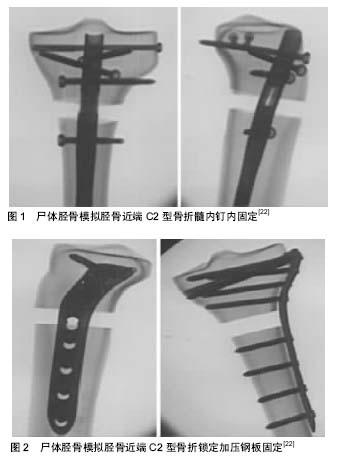| [1] Lang GJ, Cohen BE, Bosse MJ, et al. Proximal third tibial shaft fractures. Should they be nailed? Clin Orthop Relat Res. 1995;315(315):64-74.[2] Seyhan M, Unay K, Sener N. Intramedullary nailing versus percutaneous locked plating of distal extra-articular tibial fractures: a retrospective study. Eur J Orthop Surg Traumatol Orthop Traumatol. 2013;23(5):595-601.[3] Decoster TA, Nepola JV, Elkhoury GY. Cast brace treatment of proximal tibia fractures. A ten-year follow-up study. Clin Orthop Relat Res. 1988; 231(231):196-204.[4] Milner SA, Davis TR, Muir KR, et al. Long-term outcome after tibial shaft fracture: is malunion important? J Bone Joint Surg Am. 2002;84-A(6):971–980.[5] Meena RC, Meena UK, Gupta GL, et al. Intramedullary nailing versus proximal plating in the management of closed extra-articular proximal tibial fracture: a randomized controlled trial. J Orthop Traumatol. 2015;16(3):203-208.[6] Pairon P, Ossendorf C, Kuhn S, et al. Intramedullary nailing after external fixation of the femur and tibia: a review of advantages and limits. Eur J Trauma Emerg Surg. 2015;41(1):25-38. [7] Lindvall E, Sanders RT. Intramedullary nailing versus percutaneous locked plating of extra-articular proximal tibial fractures: comparison of 56 cases. J Orthop Trauma. 2009; 23(7):485-492.[8] Tytherleigh-Strong GM, Keating JF, Court-Brown CM. Extra-articular fractures of the proximal tibial diaphysis: their epidemiology, management and outcome. J R Coll Surg Edinb. 1997;42(5):334-338.[9] Freedman EL, Johnson EE. Radiographic analysis of tibial fracture malalignment following intramedullary nailing. Clin Orthop Relat Res. 1995;(315):25-33.[10] Krettek C, Stephan C, Schandelmaier P, et al. The use of Poller screws as blocking screws in stabilising tibial fractures treated with small diameter intramedullary nails. J Bone Joint Surg Br. 1999;81(6):963-968. [11] Vidyadhara S, Sharath KR. Prospective study of the clinico-radiological outcome of interlocked nailing in proximal third tibial shaft fractures. Injury. 2006;37(6):536-542.[12] Josten C, Marquass B, Schwarz C, et al. Intramedullary nailing of proximal tibial fractures. Complications and risk factors. Der Unfallchirurg. 2010;113(1):21-28.[13] 张庆杰,王永清,熊庆广,等. 锁定多向带锁髓内钉治疗胫骨平台骨折[J]. 中华骨科杂志,2016,36(13):833-840.[14] 黄涛,马凯. 多功能带锁髓内钉与双钢板治疗胫骨近端关节外骨折的临床效果比较[J]. 创伤外科杂志, 2017,19(2):126-129.[15] Attal R, Hansen M, Kirjavainen M, et al. A multicentre case series of tibia fractures treated with the Expert Tibia Nail (ETN). Arch Orthop Trauma Surg. 2012;132(7):975-984. [16] Trlica J, Dedek T, Smejkal K, et al. Expert Tibial Nail (ETN) for treatment of diaphyseal tibial fractures in current and extended indications: technique and clinical results. Acta Chirurgiae Orthopaedicae Et Traumatologiae Cechoslovaca. 2010;77(3):235-241.[17] 王永清,罗先正,刘长贵. 国人股骨胫骨髓腔的形态学研究及带锁髓内钉的改进[J]. 中华骨科杂志,1998,18(4):215-218. [18] Hiesterman TG, Shafiq BX, Cole PA. Intramedullary nailing of extra-articular proximal tibia fractures. J Am Acad Orthop Surg. 2011;19(11):690-700.[19] Lembcke O, Rüter A, Beck A. The nail-insertion point in unreamed tibial nailing and its influence on the axial malalignment in proximal tibial fractures. Arch Orthop Trauma Surg. 2001;121(4):197-200.[20] Liporace FA, Stadler CM, Yoon R S. Problems, tricks, and pearls in intramedullary nailing of proximal third tibial fractures. J Orthop Trauma. 2013;27(1):56-62.[21] 周星衡,董黎敏,叶金铎,等. 带锁髓内钉与锁定加压接骨板固定胫骨近端骨折的有限元分析[J]. 实用骨科杂志, 2014,20(11): 995-998.[22] Högel F, Hoffmann S, Panzer S, et al. Biomechanical comparison of intramedullar versus extramedullar stabilization of intra-articular tibial plateau fractures. Arch Orthop Trauma Surg. 2013;133(1):59-64.[23] 冯卫,刘建国,裴福兴.带锁髓内钉在胫骨近端骨折的生物力学研究及临床应用[J].中国生物医学工程学报,2005,24(6):728-732.[24] Hansen M, Mehler D, Hessmann MH, et al. Intramedullary stabilization of extraarticular proximal tibial fractures: a biomechanical comparison of intramedullary and extramedullary implants including a new proximal tibia nail (PTN). J Orthop Trauma. 2007;21(10):701-709.[25] Lee SM, Oh CW, Oh JK, et al. Biomechanical analysis of operative methods in the treatment of extra-articular fracture of the proximal tibia. Clin Orthop Surg. 2014; 6(3):312-317.[26] Kandemir U, Herfat S, Herzog M, et al. Fatigue failure in extra-articular proximal tibia fractures: locking intramedullary nail versus double locking plates-a biomechanical study. J Orthop Trauma. 2017;31(2):e49-e54.[27] 罗先正,邱贵兴. 髓内钉内固定[M]. 2版.北京:人民卫生出版社, 2008:31-36.[28] 李哲,孙贺,付世杰,等. 交锁髓内钉治疗胫骨近端骨折的临床分析[J]. 临床医药文献电子杂志, 2015,2(7):1247-1247.[29] 孙业青,吴卫平,楼列名,等. 胫骨、股骨干骨折合并同侧膝关节内骨折的髓内钉治疗[J]. 中国骨与关节损伤杂志, 2004,19(6): 369-371. [30] 张宏其,龙文荣,李康华,等. 半圆形动态交锁髓内钉治疗胫骨平台伴胫骨上段骨折[J]. 中华创伤杂志, 2001, 17(3):148-150.[31] 孙效虎,袁景. 锁定钢板联合带锁髓内钉治疗胫骨多段骨折[J]. 临床骨科杂志, 2016, 19(1):126-126.[32] 丁强,李超,刘又文,等.交锁髓内钉附加钛板固定治疗胫骨骨折不愈合疗效观察[J].中国骨与关节损伤杂志,2014,29(4):402-403.[33] Kim KC, Lee JK, Hwang DS, et al. Provisional unicortical plating with reamed intramedullary nailing in segmental tibial fractures involving the high proximal metaphysis. Orthopedics. 2007;30(3):189-192.[34] Archdeacon MT, Wyrick JD. Reduction plating for provisional fracture fixation. J Orthop Trauma. 2006;20(3):206-211.[35] 陈金亮,江起庭,朱东波,等. 交锁髓内钉联合钢板在胫骨近端斜形骨折治疗中的应用[J]. 实用手外科杂志, 2015, 29(2): 186-187.[36] 郭伟,杜静德. 胫骨髓内钉联合阻挡钉治疗胫骨干骺端骨折[J]. 实用骨科杂志, 2014,20(9):852-854.[37] Ricci WM, O'Boyle M, Borrelli J, et al. Fractures of the proximal third of the tibial shaft treated with intramedullary nails and blocking screws. J Orthop Trauma. 2001;15(4): 264-270.[38] 王庆,罗建宁,李欣玻.阻挡螺钉技术在胫骨交锁髓内钉治疗胫骨近端骨折中的应用[J].中国骨与关节损伤杂志,2014,29(1):76-77.[39] 祝海炳,武理国,方智松,等.阻挡钉结合生根技术在带锁髓内钉治疗胫骨远端骨折中的应用[J].中国骨伤,2012,25(7):569-571.[40] Sayana MK, Davis BJ, Kapoor B, et al. Fracture strain and stability with additional locking screws in intramedullary nailing: a biomechanical study. J Trauma Acute Care Surg. 2006;60(5):1053-1057.[41] Laflamme GY, Heimlich D, Stephen D, et al. Proximal tibial fracture stability with intramedullary nail fixation using oblique interlocking screws. J Orthop Trauma. 2003;17(7):496-502.[42] Horn J, Linke B, Höntzsch D, et al. Angle stable interlocking screws improve construct stability of intramedullary nailing of distal tibia fractures: a biomechanical study. Injury. 2009; 40(7):767-771. [43] 孙晓亮, 孙有声, 刘志伟,等. 交锁髓内钉治疗胫骨近端骨折(附46例报告)[J].中国骨与关节损伤杂志, 2000, 15(6):451-452.[44] 林成寿, 刘寿坤, 吴锦清,等. AO解剖型胫骨髓内钉微创治疗胫骨远端骨折[J].创伤外科杂志, 2010, 12(6):520-522.[45] Song SJ, Jeong BO. Three-dimensional analysis of the intramedullary canal axis of tibia: clinical relevance to tibia intramedullary nailing. Arch Orthop Trauma Surg. 2010; 130(7):903-907.[46] Schmidt AH, Templeman DC, Tornetta P, et al. Anatomic assessment of the proper insertion site for a tibial intramedullary nail. J Orthop Trauma. 2002;16(1):23-25.[47] 陈震宇,任栋. 胫骨近端骨折不同进钉点交锁髓内钉固定的生物力学比较[J].河北医科大学学报, 2014, 35(3):269-271.[48] Mcconnell T, Rd TP, Tilzey J, et al. Tibial portal placement: the radiographic correlate of the anatomic safe zone. J Orthop Trauma. 2001; 15(3):207-209.[49] 韦阁. 交锁髓内钉治疗胫骨Ⅱ区骨折43例分析[J]. 华夏医学, 2004,17(4):577-578.[50] Morandi M, Banka T, Gaiarsa GP, et al. Intramedullary nailing of tibial fractures: review of surgical techniques and description of a percutaneous lateral suprapatellar approach. Orthopedics. 2010;33(3):172.-179.[51] Tornetta P 3rd, Collins E. Semiextended position of intramedullary nailing of the proximal tibia. Clin Orthop Relat Res.1996;(328):185-189.[52] Jones M, Parry M, Whitehouse M, et al. Radiologic outcome and patient-reported function after intramedullary nailing: a comparison of the retropatellar and infrapatellar approach. J Orthop Trauma. 2014;28(5):256-262. [53] Franke J, Hohendorff B, Alt V, et al. Suprapatellar nailing of tibial fractures-Indications and technique. Injury. 2016;47(2): 495-501.[54] 解冰,杨超,田竞,等. 髌上入路胫骨髓内钉治疗胫骨近端骨折[J]. 中国骨伤, 2015, 28(10):955-959.[55] Sanders RW, Dipasquale TG, Jordan CJ, et al. Semiextended intramedullary nailing of the tibia using a suprapatellar approach: radiographic results and clinical outcomes at a minimum of 12 months follow-up. J Orthop Trauma. 2014; 28(5):245-255.[56] Eastman JG, Tseng SS, Lee MA, et al. The retropatellar portal as an alternative site for tibial nail insertion: a cadaveric study. J Orthop Trauma. 2010; 24(11):659-664.[57] Gelbke MK, Coombs D, Powell S, et al. Suprapatellar versus infra-patellar intramedullary nail insertion of the tibia: a cadaveric model for comparison of patellofemoral contact pressures and forces. J Orthop Trauma. 2010; 24(11): 665-671. |
.jpg) 文题释义:
文题释义:

.jpg)
.jpg) 文题释义:
文题释义: